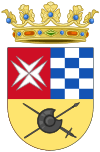Argamasilla de Alba
| Argamasilla de Alba | ||
|---|---|---|
| Municipality | ||
|
Castle of Argamasilla de Alba | ||
| ||
 Argamasilla de Alba Location in Spain. | ||
| Coordinates: 39°7′45″N 3°5′20″W / 39.12917°N 3.08889°W | ||
| Country |
| |
| Autonomous community | Castile-La Mancha | |
| Province | Ciudad Real | |
| Comarca | Mancha Alta | |
| Judicial district | Tomelloso | |
| Government | ||
| • Mayor | Pedro Ángel Jiménez Carretón (PSOE) | |
| Area | ||
| • Total | 241,82 km2 (9,337 sq mi) | |
| Elevation | 671 m (2,201 ft) | |
| Population (2015) | ||
| • Total | 7,110 | |
| • Density | 0.29/km2 (0.76/sq mi) | |
| Demonym(s) | Argamasilleros | |
| Time zone | CET (UTC+1) | |
| • Summer (DST) | CEST (UTC+2) | |
| Postal code | 13710 | |
Argamasilla de Alba is a municipality in the Province of Ciudad Real, Castile-La Mancha, Spain. It has a population of 6,791. Cervantes refers to Argamasilla in a mocking way, no doubt because of its name ("argamasilla" means "mortar") at the end of Don Quijote Part I. (Argamasilla de Alba has never had academicians of any type, contrary to the joke found there.) According to local legend, not accepted by modern Cervantes scholars, Cervantes was held prisoner here and refers to the place in the prologue to Don Quixote, in which he was "engendered in a jail". (Modern Cervantes scholars believe this is a reference to Cervantes' well-documented imprisonment in the Cárcel Real of Seville.) The town tourist and cultural office is located in a rebuilt house, the "Casa de Medrano", which contains beneath the "Cave of Medrano", in which Cervantes' imprisonment allegedly took place. In the nineteenth century, Juan Eugenio Hartzenbusch had a printing press set up in the cave and printed there an edition of Don Quijote. The Asociación de Cervantistas held its annual meeting in Argamasilla de Alba in 1995, and a second meeting in 2005.[1] es:José María Casasayas, founder of the Asociación de Cervantes, delivered in 1999 a paper in which he proposed that Don Quijote's town in Part I was Argamasilla de Alba, but in Part II, internal evidence suggests it was Argamasilla de Calatrava, a confusion deliberately created by Cervantes.[2]
References
- ↑ Perspectivas en los estudios cervantinos. (Homenaje a José María Casasayas). Ed. José Ramón Fernández de Cano y Martín. Cervantes 17.1 (1997): 4-180. Existen dos portadas, una con foto de Casasayas. En línea: <http://www2.h-net.msu. edu/~servants/s97.htm>.
- ↑ Anales Cervantinos, 35, 1999.
Coordinates: 39°07′N 3°06′W / 39.117°N 3.100°W

